|
What is a Date/Time?
In Access, a date/time is actually a number, based on the number of
days and fractions of a day since midnight December 30, 1899. Dates before
that day are stored as negative numbers. Access can handle dates from
January 1, 100 AD through Dec. 31, 9999 AD. Should be enough for most
uses!
Examples of dates:
Dec. 31, 1899 = 0
Jan. 1, 1900 = 1
Nov. 30, 1899 = -30
Examples of dates with times:
The date is the whole number part and the time is the decimal
fraction of a day.
Dec. 30, 2000 6:00 am=
36,890.2500000000
July 15, 1941 3:36:00 PM =
15,172.6500000000,
We are all very happy to let Access do the translation so that we can
work with normal looking dates and times!
 All dates include time:
Every date also has a time as the decimal part of the number. If
you do not set a specific time, Access interprets the time as midnight,
since the decimal value for midnight is .0000000000. All dates include time:
Every date also has a time as the decimal part of the number. If
you do not set a specific time, Access interprets the time as midnight,
since the decimal value for midnight is .0000000000.
 Date/Time as text: If
you choose the Text data type for a field that will hold a date or time, you
will not be able to calculate with the field or switch its display
format, like from 2/5/2004 to February 5, 2004. Date/Time as text: If
you choose the Text data type for a field that will hold a date or time, you
will not be able to calculate with the field or switch its display
format, like from 2/5/2004 to February 5, 2004.
Working with Date/Time Values
Calculating with dates and times can be complicated. Access
provides a number of helpful functions. These functions often use one of
several text strings for the various time intervals that we are most
often interested in.
Intervals- Values you can use for interval
in a function (must include the quotes):
- "yyyy" = four-digit year
- "y" = serial day of the year (1 - 366) (Example: Feb. 15 is
day 46.)
- "m" = month (1 - 12)
- "q" = quarter (1 - 4)
- "ww" = week of the year (1 - 52)
- "w" = day of the week (1 - 7)
- "d" = day of the month (1 - 31)
- "h" = hour (1 - 24)
- "n" = minute (1 - 60)
- "s" = seconds (1 - 60)
Date Part: Pull out part of a Date/Time
General Form: DatePart(interval, date)
- interval is a text string from the list above for the part of the date you
want to see and date is a field name or a calculated value that
results in a date/time.
There are two optional parts to this function that are not likely to
use very often:
DatePart(interval,
date [,firstweekday [,firstweek)
firstweekday
is the number of the day of the week that you want to use as the
first day. The default is Sunday.
firstweek is the week number that you want to use as the first week
of the year. The default value is the week that contains January 1.
Examples:
DatePart("yyyy",[Birthdate]) will produce
the year part of the Birthdate value.
DatePart("m",[Birthdate]) will produce
the month part of the Birthdate value.
DatePart("d",Now()+30) will produce the
day that is 30 days from today
DatePart("w",Now(),2) will produce the
number of day of the week, starting with Monday as day 1.
DateAdd: Add to or subtract interval(s) from a Date/Time
General Form: DateAdd(interval, number, date)-
Takes the date and adds the given number of intervals
to it. A negative number will subtract that many intervals.
Examples:
DateAdd("m",2,[MyDate]) will add 2 months
to the value in MyDate.
DateAdd("yyyy",-10,[MyDate]) will
subtract 10 years from the value in MyDate.
DateDiff: Difference between two dates
General Form: DateDiff(interval, date1, date2)
- Finds the number of intervals between date1 and
date2. The value is positive if date2 is later than date1 and is
negative date1 is the later date.
Like the DatePart fucntion, there are two optional parts to this
function:
DateDiff(interval, date1, date2 [,firstweekday
[,firstweek)
firstweekday
is the number of the day of the week that you want to use as the
first day. The default is Sunday.
firstweek is the week number that you want to use as the first week
of the year. The default value is the week that contains January 1.
Examples:
DateDiff("yyyy", [SoldDate],Now()) will
show the number of years between today and the value in SoldDate.
DateDiff("d",[PurchaseDate], [ShippedDate])
finds the number of days between the two dates.
DateValue: Turn a text string date into a number
When a field for dates is set up as text and later you want to
calculate with that date, you need a function to turn the text into a
number.
General Form: DateValue(date)
- returns
the number that represents the text string date, like
"October 14, 2000".
Examples:
DateValue("Sept. 11, 2001") returns the
value 9/11/2001.
DateValue([DateGraduated]) returns the
value 5/5/1999 when the field has the text value "May 5, 1999".
Format: Pattern for display a date/time
The Format function allows you to choose a standard pattern or create
your own pattern for how to display a Date/Time value. The Format
function can, of course, display only part of a date/time value. Don't
confuse it with the DatePart function, however. The DatePart function can
only pull out one part of the date/time value, like the month or
day or year or hour.
General Form: Format(datetime, pattern)
- takes the datetime value and formats it like pattern.
Examples:
Format(Now(),"dddd, mmm d yyyy")
returns "Tuesday, Mar 7 2006" if the current date is 03/07/2006.
Only the punctuation that you include in the pattern will show
up.
Format(Now(),"h:m:s") return the time
portion, like 13:23:45 if the current time is 1:23:45 pm.
You can also use the standard date/time formats for the pattern:
|
Format Pattern: |
Produces: |
| General
Date |
3/8/2006
10:39:59 AM |
| Short Date |
3/8/2006 |
| Medium Date |
08-Mar-06 |
| Long Date |
Wednesday,
March 08, 2006 |
| Short Time |
10:39 |
| Medium Time |
10:39 AM |
| Long Time |
10:39:59 AM |
Special Expression for Calculating an Age/Anniversary:
It is easy to be off by a year when trying to calculate someone's age
or an anniversary of some sort. An age/anniversary depends on whether or
not the one for this year has occurred yet. You cannot just find the difference
between the years. You must consider the month and day and compare them
with today. So confusing!
Microsoft suggests a messy-looking but effective expression to handle
this issue. It combines 3 functions: DateDiff,
Format, and Int.
Age: DateDiff("yyyy", [Birthdate], Now())+ Int(
Format(Now(), "mmdd") < Format( [Birthdate], "mmdd") )
Let's break this mess apart to see how it works.
Age will be the number of years from the DateDiff
calculation plus 0, if we have
passed the birth day already, or plus negative 1 (-1), if the birth day
is still in the future.
-
DateDiff("yyyy", [Birthdate],
Now()) calculates the difference between the year of the birth
date and the current year. This is all you would need if you KNEW that
the birthday for this year had already passed.
-
Format(Now(), "mmdd")
returns the month and day for today's date.
-
Format( [Birthdate],
"mmdd") returns the month and day for the birth date
-
Format(Now(), "mmdd")
< Format( [Birthdate], "mmdd") asks if the month and day for today
is before the month and day in the birth date. So, if today is March 5,
2006 and the birth date is May 25, 1972, we are looking at the question
"Is March 5 < May 25", which is True.
-
Int(expression)
The Int function returns the integer part of a number. In this case we
are using the Int function to get a number out of a logical comparison.
A weird feature of programming is that True and False have to actually be
number values for a computer to work with them.
A False expression evaluates to 0. A True expression evaluates to -1.
So when today's date is before the birthday, the Int part is -1 and the
full expression for Age adds -1 to the DateDiff. TaDa! We have the
correct age, as of today! As soon as we get to May 25, the Int part of
the expression evaluates to 0 and the DateDiff result is the true age.
 |
Step-by-Step: Calculated Values - Dates |
 |
|
What you will learn: |
to write a simple calculation for a new field
to use the Format function
to use the Expression Builder
to get Help for a function from Expression Builder
to use the DateDiff function
to correct a date calculation based on the current date/time
to use the DateAdd function
to group and count records
to use the DatePart function |
Start with:
 ,
Projects
database open. ,
Projects
database open.
 Do
not panic when your results are different from the illustrations. You
will be using the Now() function, which produces the current date
and time. Therefore, you will see different results every day! Do
not panic when your results are different from the illustrations. You
will be using the Now() function, which produces the current date
and time. Therefore, you will see different results every day!
Calculate Length of Service
The Staff table in the
Projects database includes the date the person was hired. You will create
a calculated field to show how many years this person has been working
for World Travel Inc. First, you will use a simple expression.
Since this value will be wrong during part of the year, you will have to
use a more complex expression to get the number right. <sigh>
-
If necessary, open the Projects
database from your Class disk.
-
Open the list of queries in the Database Window.
-
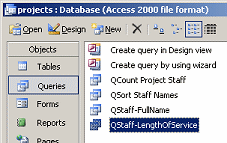 Right
click on the query QStaff-FullName. Right
click on the query QStaff-FullName.
-
Select .
-
Right click in a blank are of the Database Window
and select .
-
Name the new query
QStaff-LengthOfService
-
Open the new query in Query Design View.
-
Drag the DateHired
field to the first blank column at the right in the grid.
-
In the next blank column, create a new field:
LengthOfService: Now()-[DateHired] which
subtracts the date/time hired from the current date/time.
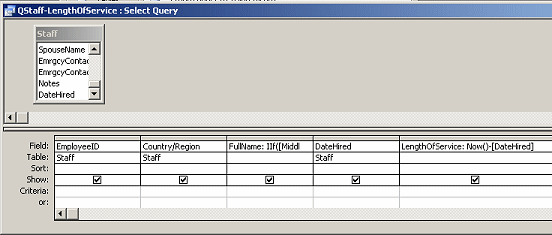
-
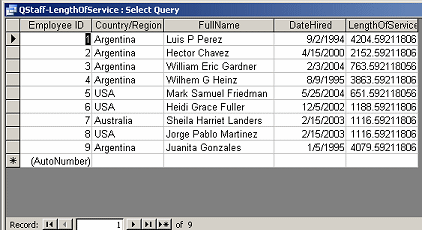  Run the query. Run the query.
Unexpected result! The LengthOfService field shows a
bunch of decimal numbers! What do these values mean?
[Your numbers will be different from the illustration
since the Now function uses the current date and time.]
The integer part of each value (to the left of the
decimal) is the number of days
since the person was hired. The decimal part (to the right of the
decimal) is the number of hours.
Because the DateHired values
do not have a time included, Access assume that the time was midnight, .000000000.
That is why the decimal part is the same for all the values.
Stretch Your Brain: Can you figure out what day
and time the illustration was captured based on the LengthOfService
values??
-
 Save the
query. (QStaff-LengthOfService) Save the
query. (QStaff-LengthOfService)
Use Format Function
You need to use the Format function to get the number of
years instead of the messy number for LengthOfService. Remember that the
values change as time marches on!
Syntax for Format: Format
(datetime, pattern)
-
 Switch back to
Query Design View. Switch back to
Query Design View.
-
Edit the calculated field to subtract the year hired
from the current year:
LengthOfService: Format(Now(),"yyyy")-Format([DateHired],"yyyy")
![Zoom window: LengthOfService: Format(Now(),"yyyy")-Format([DateHired],"yyyy")](query-lengthofservice-formatzoom.gif) The
Format function pulls just part of a date/time value for the expression or field.
The "yyyy"
tells the Format function that you want just the year part. The
Format function pulls just part of a date/time value for the expression or field.
The "yyyy"
tells the Format function that you want just the year part.
 Use the Zoom
window so you can see what you are doing. Use the Zoom
window so you can see what you are doing.
-
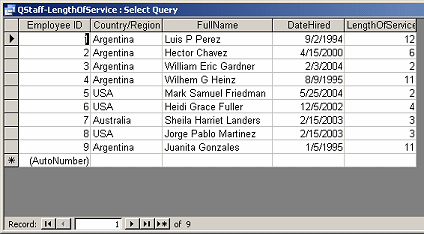  Run
the query. Run
the query.
Better!!
Use Expression Builder with the DateDiff Function
Access provides a special function for finding the
difference between two dates. Perhaps it will be less complicated!
While the Zoom window gives you more space to see what
you are typing, the Expression Builder can show you the syntax for
functions. Very helpful!
Syntax for DateDiff:
DateDiff(interval, date1, date2)
interval is a code for what you want to count, for example the
number of years, months, days, or quarters.
If date2 is later than date1, the difference will be a positive number.
-
 Switch back to
Query Design View. Switch back to
Query Design View.
-
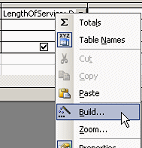 Right
click the LengthOfService field and from
the popup menu select . Right
click the LengthOfService field and from
the popup menu select .
The Expression Builder window opens and shows the current expression.
![Expression Builder: LengthOfService: Format(Now(),"yyyy")-Format([DateHired],"yyyy")](expressionbuilder-length-format.gif)
The left column shows the objects and functions you might want to use in
an expression. The middle column shows the choices or parts the the item
selected in the left column. The right column shows the choices for what
you selected in the middle column.
-
 Experiment by choosing various items in the first column and middle
column. Do you see how these columns are working??
Experiment by choosing various items in the first column and middle
column. Do you see how these columns are working??
-
Delete everything in the expression at the top
of the dialog except the field name, LengthOfService:
-
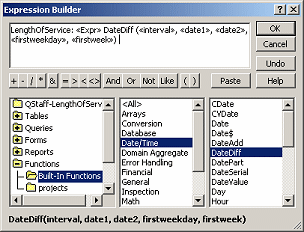 Double-click Functions in the left column to
expand the list. Double-click Functions in the left column to
expand the list.
-
Click on Built-in Functions. A list appears
in the middle window of the categories of functions that Access already
knows.
-
Click on Date/Time in the middle column. A
list of functions appears in the right column.
-
Click on DateDiff to select it. At the
bottom of the window appears the syntax of this function.
What if you don't remember what the parts of the function represent? Help
is available!
-
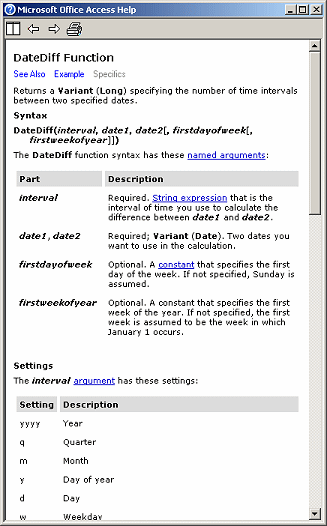 Click
the Help button. TaDa! A complete explanation of the function
appears. Click
the Help button. TaDa! A complete explanation of the function
appears.
 Visual Basic: Don't get too
confused. This Help info is actually from the Help articles for Visual
Basic, which is a programming language. The example link opens a Visual
Basic example. You can include most functions in an expression in a
calculated field or control. Visual Basic: Don't get too
confused. This Help info is actually from the Help articles for Visual
Basic, which is a programming language. The example link opens a Visual
Basic example. You can include most functions in an expression in a
calculated field or control.
-
Close the Help window.
-
Double-click DateDiff in the right column. The function is inserted
into the existing expression, with placeholders for all the possible
parts. Next you must replace or delete those placeholders.
-
Edit the expression to read:
LengthOfService: DateDiff ("yyyy", [DateHired], Now())
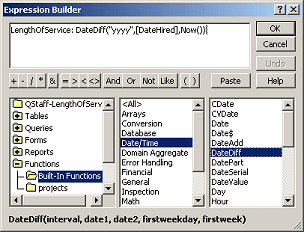 where the interval is "yyyy", date1 is [DateHired], and
date2 is Now().
where the interval is "yyyy", date1 is [DateHired], and
date2 is Now().
-
Click on OK to accept the new expression and
close the Expression Builder window.
-
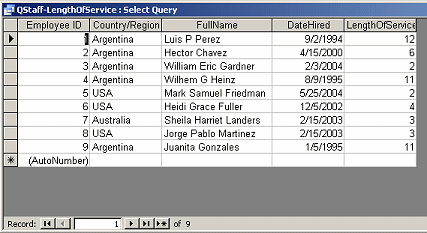  Run
the query. Run
the query.
The values from this calculation are the same as before, as they should
be.
The expression using DateDiff is a bit shorter than the previous version
using Format. That's about the only difference.
In fact, the hardest part for both functions is remembering the order of
the parts! The Expression Builder handles that for you!
(Your values will be at least somewhat different than those in the
illustration since Now() is a different date for you.)
Correcting for Where We Are in the Year
Your current expression for
LengthOfService gives you a number of years that is guaranteed to
be true only at the end of the year! If the anniversary date has not
arrived yet, the number is off by 1 year.
To show the length of service as of today,
you must adjust your
expression to subtract a year if the anniversary date has not yet arrived.
Happily, Microsoft provides a sample expression, discussed
above.
Syntax for expression to calculate the number of years between
the current date and another date:
NumberOfYears: DateDiff("yyyy", <date>, Now()) +
Int(Format(Now(), "mmdd") < Format(<date>, "mmdd") ) where <date>
is some calendar date or expression that produces a calendar date.
-
 Switch back to
Query Design View. Switch back to
Query Design View.
-
Edit the LengthOfService
field to read:
LengthOfService: DateDiff("yyyy",[DateHired],Now())+Int(Format(Now(),"mmdd")<Format([DateHired],"mmdd"))
![Zoom: LengthOfService: DateDiff("yyyy",[DateHired],Now())+Int(Format(Now(),"mmdd")<Format([DateHired],"mmdd"))](query-lengthofservice-int-zoom.gif)
-
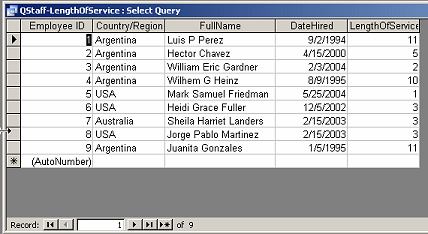  Run
the query. Run
the query.
Now the LengthOfService is reduced by 1 for
those dates that have not yet occurred.
(Your numbers will be different! I captured the image on March 7, 2006.)
-
 Save
the query. (QStaff-LengthOfService) Save
the query. (QStaff-LengthOfService)
Use the DateAdd Function
World Travel Inc. holds a special party for employees
when they reach 10 years of service. You will write an expression that
will calculate everyone's 10 year anniversary by using the DateAdd
function. This function does not add two dates together! Instead, it adds
a certain number of intervals to a date. You can add so many years or
months or days or hours, etc.
Syntax for DateAdd:
DateAdd(interval, number, date)
-
 Switch back to
Query Design View. Switch back to
Query Design View.
-
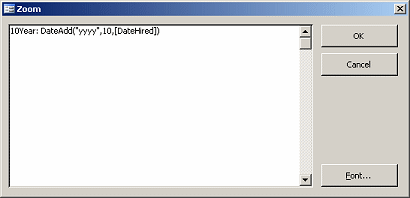 Create
a new calculated field: Create
a new calculated field:
10Year:DateAdd("yyyy",10,[DateHired])
This expression says to add 10 years to DateHired.
-
Sort the new field Ascending and remove the
sorting for the three name fields.
-
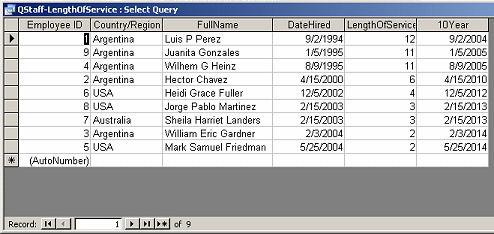  Run
the query. Run
the query.
You can see from the column 10Year that some anniversaries have already
passed... unless it is January 1, 2, 3, or 4 when you do this exercise!
-
 From the
menu select |
and name the
query QStaff-10Year. From the
menu select |
and name the
query QStaff-10Year.
Group by Anniversary and Count
Suppose you want to know how many employees will have a 10-year
anniversary in each year. You can use the Total row to count them. Just
remember that in a Totals query you want to show only the field(s) that you are grouping by and
the column that you are using to count.
-
 Switch back to the
Query Design View. Switch back to the
Query Design View.
-
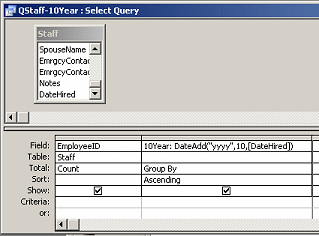 Delete
all the columns except EmployeeID and
10Year. Delete
all the columns except EmployeeID and
10Year.
- Click the Totals button
 to show the Total row in the grid.
to show the Total row in the grid.
- In the Total row, select Count for the EmployeeID
column and Group By for the 10Year column.
Be sure that both columns have the Show box checked.
-
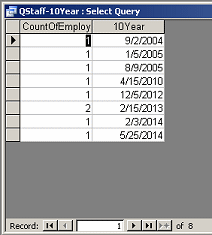  Run
the query. Run
the query.
Hmmm. This grouping is on the whole date, not just the year. There
actually were two employees who were hired on the same date. This is not
quite what we wanted to see.
-
 Save the
query as QStaff-10Year-Grouped. Save the
query as QStaff-10Year-Grouped.
Use the DatePart Function
You need to make the query look only at the year part of the date. The
DatePart function can come to the rescue!
Syntax for DatePart: DatePart(interval,
date)
-
 Switch back to
Query Design View. Switch back to
Query Design View.
- Edit the expression for the 10Year field to read:
10Year: DatePart("yyyy",DateAdd("yyyy",10,[DateHired]))
![Zoom: 10Year: DatePart("yyyy",DateAdd("yyyy",10,[DateHired]))](query-10year-datepart-zoom.gif) This
changes the expression to show just the year portion of the date that DateAdd
comes up with. This
changes the expression to show just the year portion of the date that DateAdd
comes up with.
-
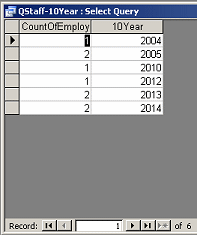  Run
the query. Run
the query.
Now we can see groupings!
-
 Save this query. (QStaff-10Year-Grouped)
Save this query. (QStaff-10Year-Grouped)
 To see the number of anniversaries in a
particular year, you could
add the year to the Criteria row in the 10Year column. To see the number of anniversaries in a
particular year, you could
add the year to the Criteria row in the 10Year column.
|

